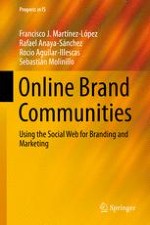2016 | OriginalPaper | Chapter
2. Evolution of the Web
Authors : Francisco J. Martínez-López, Rafael Anaya-Sánchez, Rocio Aguilar-Illescas, Sebastián Molinillo
Published in: Online Brand Communities
Publisher: Springer International Publishing
Activate our intelligent search to find suitable subject content or patents.
Select sections of text to find matching patents with Artificial Intelligence. powered by
Select sections of text to find additional relevant content using AI-assisted search. powered by
